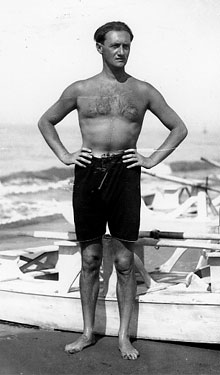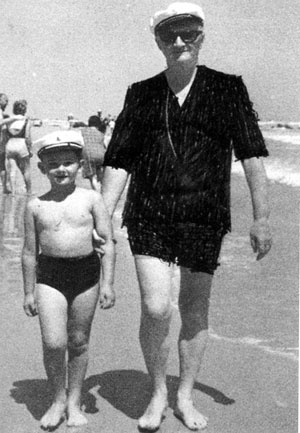Biography
7 May 1890: Arnaldo Ginna (pseudonym of Arnaldo Ginanni Corradini) was born in Ravenna, to an aristocratic family. He studied at the Academy of Fine Arts, with his brother Bruno, who was more inclined to literary studies, and became interested in many disciplines including occult sciences, alchemy, alternative medicine, theosophies, and oriental philosophies.
1908: He experimented with pure colour painting with strong spiritualistic inflections and painted his first non-figurative painting Nevrastenia, a forerunner of the abstract painting experiences later made in Europe.
1910: Together with his brother Bruno, he published Metodo, Vita nova and Arte dell’Avvenire, the latter a first, avant-garde text of the 20th century. Once again, along with his brother, he experimented new artistic techniques with the aim of creating a fusion between the arts (chromatic music) and several abstract short films that he produced, through the application of colour directly onto untreated film.
1911: He exhibited ceramic clays along with two paintings at the Faenza Art Exhibition.

c. 1912: In Milan, he was introduced to Marinetti, Boccioni, Carrà and Russolo through his friend, the Futurist musician Francesco Balilla Pratella, and together with Bruno, he joined the Futurist Movement. He moved to Florence where he participated in the Painting and Sculpture Exhibition at the Società di Belle Arti, exhibiting two abstract paintings. He began to collaborate on the editorial staff of ‘Il Centauro’ and ‘La Rivista’.
1914: He received a Diploma at the Accademia delle Belle Arti in Florence. He became one of the main exponents of the so-called ‘Pattuglia Azzurra’ or ‘Second Florentine Futurism’. In April, he participated in the Free International Futurist Exhibition organised at the Sprovieri Gallery in Rome, displaying six of his artworks, in which works by Kandinsky and Archipenko were also presented. Giacomo Balla futuristically christened his two brothers with their stage names Ginna (by combining Ginanni and “ginnastica” gymnastics) and Corra (by combining Corradini and “corsa” running). He became interested in futurist furniture pieces and began making some.
1915: He wrote the theoretical text Pittura dell’avvenire (later published with a preface by Corra in 1917).
1916: He participated in founding the ‘L’Italia Futurista’ magazine, for which he designed illustrations, and wrote articles including essays, theoretical texts, experimental plays, short stories, and poems. He produced and directed the film Vita Futurista (Futurist Life), in collaboration with Corra, Balla and Marinetti and created the Manifesto of Futurist Cinematography, signed by Marinetti, Corra, Settimelli, Balla and Chiti.
1919: He published the pre-surrealist text “Le locomotive con le calze”, a collection of short stories with a preface by Corra and his own drawings and those of the Futurist artist Rosa Rosà. In the same year, he participated in the Great National Futurist Exhibition in Milan, Genoa and Florence with paintings and furniture pieces.
c. 1920: He moved to Rome.
1922: He participated in the International Futurist Exhibition at the Winter Club in Turin, exposing three paintings.
1926: He began to collaborate with ‘L’Impero’, in which he published short stories and critical essays. Subsequently, from 1930: He wrote in “Oggi e Domani” as a film and radio critic and from 1932 also published in “Futurismo”.
1933: He wrote L’uomo futuro, with a preface by Marinetti.
1934: He founded the naturist periodical “Il Nuovo” and wrote, the Manifesto of Futurist Naturism with Marinetti.
1937: He published the manifesto L’idea presentista.
1938: He updated the old manifesto written in 1916 and published La Cinematografia with Marinetti.
1940-1960: He abandoned public artistic activity. He worked in the Ministry of Tourism and Entertainment at the General Directorate of Cinematography. He continued to paint but only exhibited on one occasion, in December 1948, in a personal exhibition in Rome, at the Galleria Po.
1961: He published his own texts in the booklet “Arnaldo Ginna. Un pioniere dell’astrattismo”, by Giuseppe Sprovieri and Massimo Scaligero.
1967: Mario Verdone , a historian of the Avant-gardes, wrote an in-depth essay in the Futurist works of Ginna and Corra , and dedicated it to him in the magazine ‘Bianco e Nero’, later expanding it in the single issue of “Cinema and Literature of Futurism” in 1968.
1969: Giuseppe Appella curated a personal anthological exhibition of Arnaldo Ginna’s work in Macerata and then in Rome, exhibiting more than seventy works. Ever since, Ginna’s works have been exposed in numerous group exhibitions in important Italian and international museums.
1981: Mario Verdone published the text Futurist Manifestos and Theoretical Writings by Arnaldo Ginna and Bruno Corra.
26 September 1982: Arnaldo Ginna died at the age of 92.

Text by Lucia Collarile.
